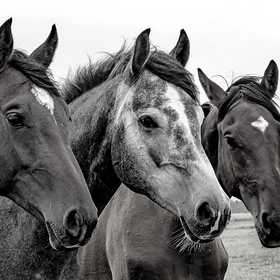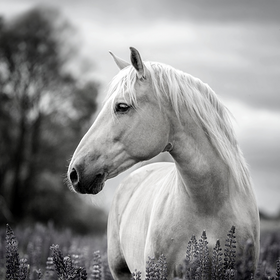
How to Store Hay & Grain
Storing hay and grain properly can help to preserve the feed, prevent mold growth and contamination, saving you significant money in the process. Here is some helpful advice to keep in mind when you are purchasing and storing hay and grain.
Grain and Concentrate Storage
Grains and concentrates should be stored securely in a grain bucket, bin, or barrel with a tight lid. Pour the grain directly into the container and discard the grain bag. This keeps the feed dry and prevents rodent and insects from eating and contaminating the grain. Rodents will leave droppings in the feed which can be harmful to your horse.
It is recommended to only purchase one month of grain at a time to prevent spoilage. Always make sure to feed all of the previous months feed before starting on the new bag. You should take care not to mix old and new feed or different kinds of feed (unless you are converting to a new feed).
Grain and concentrates with molasses are prone to freezing in cold temperatures. If you are feeding a sweet feed or senior feed, consider storing the container in a warm area to prevent the grain from freezing.
Hay Storage
Keep stored hay as fresh as possible by focusing on preventing mold development, heat buildup and combustion, and nutrient deterioration. Hay should be stored in a clean, dry environment, ideally in a covered area. Moisture causes heat and mold, both of which are dangerous for a horse.
Hay harvesting and drying is also an important element in keeping hay as fresh as possible. If hay is baled with too much moisture, it can generate significant amounts of heat and can reach spontaneous combustion temperatures and burst into flames. To reduce the risk of fire, store hay in a separate building from your horse, and place bales on straw, crushed gravel, or wooden pallets. Placing bales directly in the dirt or on concrete can lead to mold.
As you are stacking your bales, stack them on edge and leave gaps between the rows. This will help to circulate air around the hay. Air circulation and ventilation in the hay storage area will help reduce dust accumulation which often causes respiratory issues in horses.
If you do not have a covered area for hay storage, use a waterproof tarp to help protect the hay from sun, rain, and snow. Hay should not be exposed to any elements, as they will decrease hay nutrients. Canvas tarps often hold up better than plastic tarps as they are less prone to leaking. While sun exposure doesn’t seem like an issue for hay, it will speed nutrient deterioration in your hay.
Some horse owners find feeding round bales to be more cost effective. If you are feeding round bales, make sure they are thoroughly dried before being baled and stored. Round bales prepared for cattle are not a good option for horses as these are generally baled with a higher moisture level.






